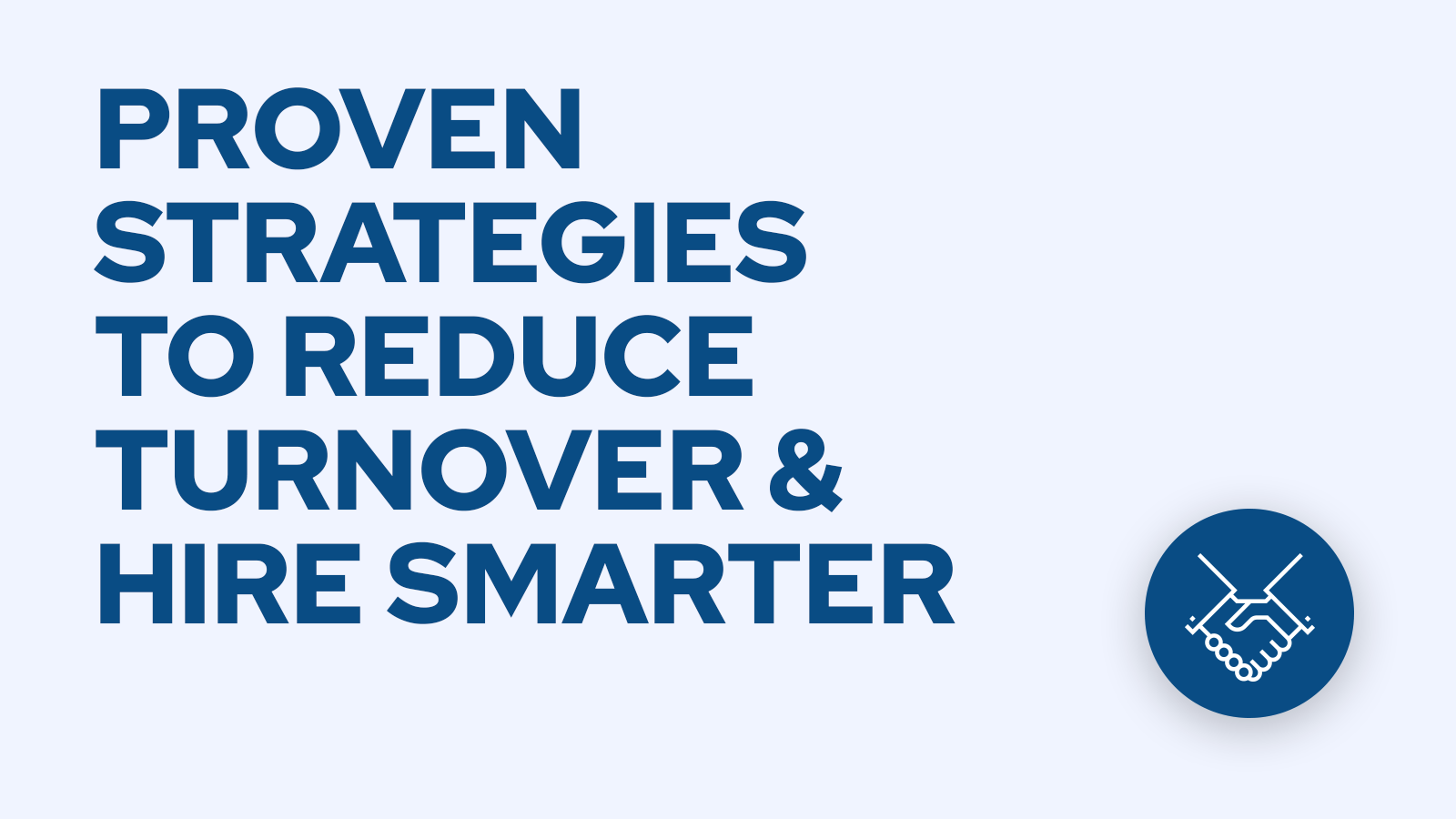Making the wrong hire doesn’t just drain budgets — it disrupts teams, slows growth, and damages culture. Traditional résumés and interviews often fail to reveal the behavioral traits that truly predict job success. That’s why more HR leaders are turning to behavioral assessments for hiring — a science-backed way to reduce bias, hire smarter, and build stronger teams.
Table of Contents
- The High Cost of a Wrong Hire
- What Are Behavioral Assessments for Hiring?
- How Behavioral Assessments Predict Job Success
- The Science Behind Hiring: Industrial and Organizational Psychology
- From Data to Decisions: Behavioral Assessments in the Hiring Process
- Reducing Bias and Increasing Fairness
- Beyond Hiring: Employee Development & Leadership Growth
- Challenges and Limitations of Behavioral Assessments
- Building a Recruitment Strategy with Behavioral Assessments
- The Future of Hiring: Data Meets Human Resources
- Conclusion: Hiring Smarter Starts with Behavioral Assessments
The High Stakes of Hiring: Behavioral Assessments for Hiring
Every hiring manager knows the sting of a bad hire. On paper, the candidate seemed like the perfect fit. In the interview, they said all the right things. But six months later, the team dynamic is strained, performance lags, and turnover looms. Research from SHRM estimates that replacing a single employee can cost as much as three to four times the position’s salary when you account for recruiting, onboarding, lost productivity, and the impact on morale.
That’s why companies hiring in today’s competitive market can no longer rely on résumés, intuition, or even well-structured interviews alone. The stakes are simply too high.
This is where behavioral assessments for hiring enter the conversation. Grounded in industrial and organizational psychology, these tools give hiring teams a deeper, scientifically validated look at a candidate’s personality traits, social skills, and workplace behaviors — the factors most predictive of long-term success. Unlike gut instincts, behavioral assessments provide data-driven insights that reduce hiring bias, improve cultural alignment, and help organizations select the right candidate before making an offer. Behavioral assessments also help hiring teams efficiently identify the best candidates for specialized and technical roles by filtering out less qualified applicants through objective evaluation processes.
And the impact isn’t limited to preventing bad hires. When used effectively, behavioral tests drive smarter recruitment strategies, reduce turnover, and strengthen company culture. In fact, leaders like Howard Schultz (Starbucks) and Warren Buffett often highlight values, mindset, and team alignment as decisive factors in hiring. Behavioral assessments can evaluate a candidate’s alignment with the company’s values, promoting cultural fit and reducing bias. Behavioral assessments give HR professionals and executives the framework to measure those qualities consistently.

The High Cost of a Wrong Hire
A single wrong hire can ripple across an organization. Beyond the immediate recruiting and onboarding costs, poor hiring decisions impact productivity, customer satisfaction, and team cohesion. According to Gallup, a disengaged employee costs their company the equivalent of 18% of their annual salary, while SHRM estimates that replacing a bad hire can reach three to four times the role’s salary.
For mid- to senior-level positions, those costs easily climb into six figures. And for leadership roles, the damage goes even deeper — undermining strategy execution, straining team dynamics, and slowing organizational growth.
The problem is clear: when hiring managers rely too heavily on résumés, gut instincts, or unstructured interviews, they increase the likelihood of these costly mistakes. Traditional methods often miss the behavioral traits — adaptability, collaboration, resilience — that determine whether a candidate will thrive in the real work environment.
This is why companies hiring top talent are adopting behavioral assessments. By providing a comprehensive view of a candidate’s potential, these tools help organizations avoid expensive missteps, make informed hiring decisions, and align talent with long-term business goals. Pre-employment assessments evaluate a candidate’s potential by measuring their overall abilities, including technical skills, cognitive capabilities, and personality traits, giving employers a holistic understanding of each candidate’s suitability for the role.
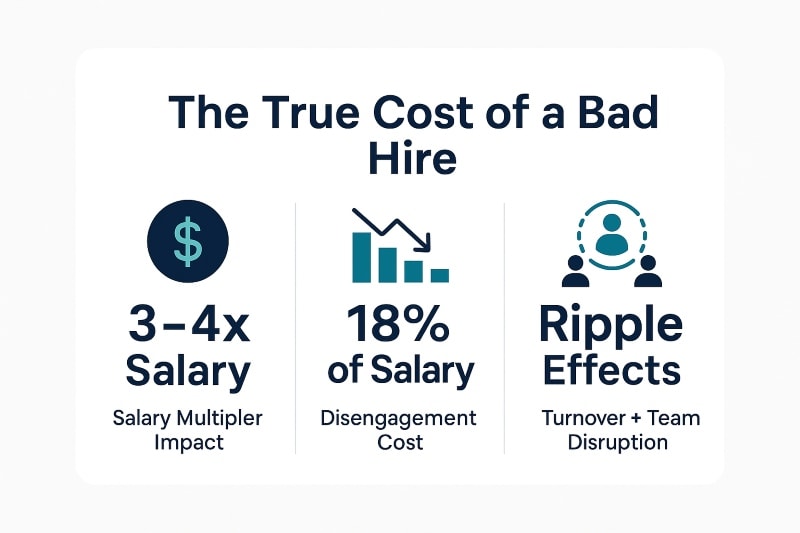
What Are Behavioral Assessments for Hiring?
Behavioral assessments are structured tools designed to evaluate the traits, motivations, and social behaviors that influence how people perform at work. Unlike cognitive ability tests, which measure problem-solving or analytical skills, or a personality test that evaluates individual traits and behaviors—often focusing on preferences and general tendencies—behavioral assessments provide a holistic view of how a candidate is likely to respond in real workplace situations. Behavioral assessments go beyond what a personality test typically measures by connecting these traits directly to workplace performance and situational responses.
Rooted in industrial and organizational psychology, these assessments are built to be scientifically validated — meaning their results are statistically reliable and predictive of future performance. They go beyond surface-level impressions to uncover behavioral traits such as adaptability, decision-making style, emotional intelligence, and collaboration.
Common examples include:
- Situational Judgment Tests (SJTs): Presenting candidates with realistic workplace scenarios to measure judgment and problem-solving.
- Psychometric Assessments: Measuring behavioral tendencies and traits through structured questions.
- Talent Assessments: Comprehensive frameworks that connect behaviors to workplace performance, team dynamics, and cultural alignment.
What sets behavioral assessments apart is their ability to give hiring teams actionable insights into whether a candidate’s traits align with the organization’s values, team dynamics, and particular role requirements. When integrated into the recruitment strategy, they provide clarity for hiring managers and ensure better long-term hiring decisions.
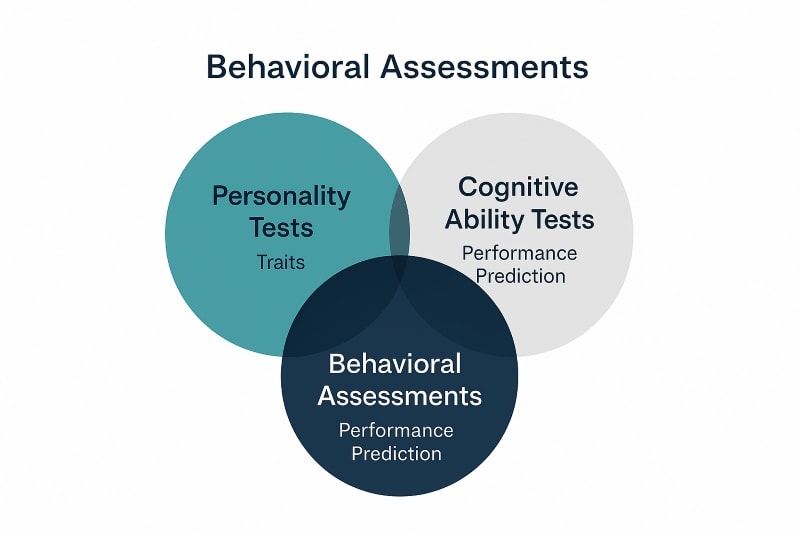
Why Resumes and Interviews Aren’t Enough
Resumes and interviews remain essential parts of the hiring process — but they often provide an incomplete picture. A polished resume highlights past achievements, yet it can’t reveal whether a candidate thrives under pressure, adapts to change, or collaborates effectively. Interviews, even when structured, are subject to bias and impression management. Research from Harvard Business Review shows that unstructured interviews are among the least predictive methods of job success, often performing no better than chance.
Hiring managers know this intuitively: candidates who “interview well” don’t always perform well once hired. This disconnect happens because traditional methods focus on what candidates say rather than how they behave. Critical factors like emotional intelligence, resilience, and team dynamics rarely come through in a 45-minute conversation.
Behavioral assessments bridge this gap. By providing a data-driven view of a candidate’s personality traits and workplace behaviors, they allow hiring teams to move beyond gut feeling. Pre-employment behavioral assessments provide objective data to support hiring decisions, helping organizations evaluate candidates’ fit before making a job offer. Instead of guessing whether a candidate will align with company culture or thrive in a particular role, HR professionals can rely on scientifically validated assessments that consistently predict workplace performance.
This combination of qualitative insight from interviews and quantitative insight from assessments creates a whole-candidate perspective — reducing hiring bias and improving informed hiring decisions.
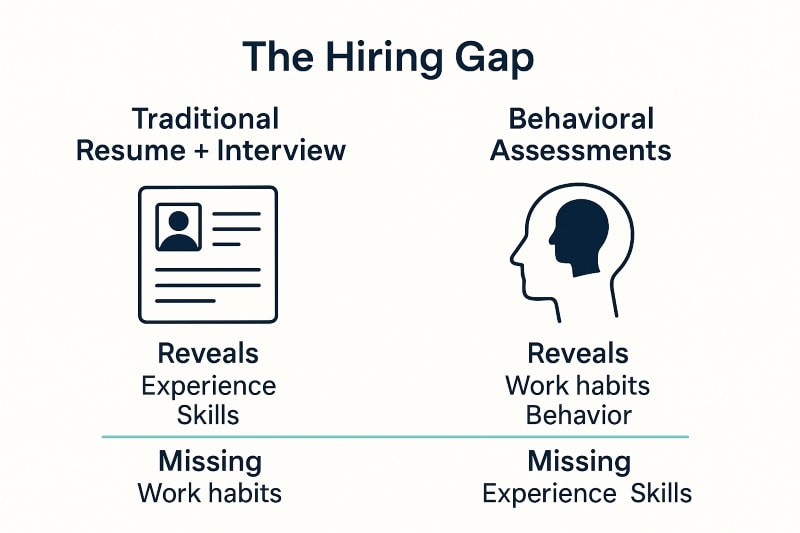
How Behavioral Assessments Predict Job Success
Success in the workplace isn’t just about technical skills. The traits that often determine whether someone excels — adaptability, communication, resilience, and collaboration — are behavioral. Traditional methods rarely measure these, but behavioral assessments are designed specifically to connect these traits to job performance.
One well-established framework is the Five Factor Model (FFM), also known as the “Big Five” personality dimensions: openness, conscientiousness, extraversion, agreeableness, and emotional stability. Studies consistently show these traits correlate strongly with workplace outcomes such as leadership effectiveness, cultural alignment, and team cohesion. Behavioral assessments also reveal a candidate’s work style, providing deeper insight into their approach to tasks and collaboration.
Behavioral assessments also measure qualities like emotional intelligence (EQ) — a proven predictor of leadership success. Research published in Industrial and Organizational Psychology highlights that EQ explains significant differences in performance between high and average leaders, particularly in roles requiring empathy, influence, and decision-making under pressure.
Situational judgment tests (SJTs) provide another lens, simulating real workplace dilemmas. By analyzing how candidates respond, hiring managers gain insights into their decision-making style, conflict resolution skills, and cultural fit.
When combined with data-driven insights, behavioral assessments help organizations make informed hiring decisions that go far beyond what a resume or interview can provide. They predict not only whether someone can do the job, but whether they will thrive — aligning with the company’s values, team dynamics, and long-term business goals.
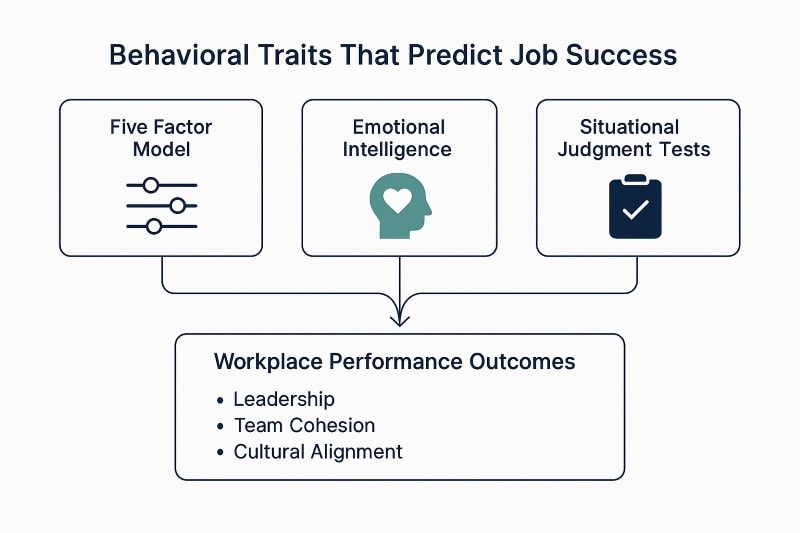
The Science Behind Hiring: Industrial and Organizational Psychology
Behind every effective hiring strategy lies the discipline of industrial and organizational psychology — the science of understanding how people behave at work and how organizations can optimize talent. This field provides the foundation for many of today’s most powerful recruitment tools, from behavioral and psychometric assessments to situational judgment tests.
At its core, organizational psychology is about replacing guesswork with scientific rigor. By using scientifically validated assessments, hiring managers can move beyond intuition and evaluate candidates on personality traits, cognitive ability, and behavioral tendencies. This ensures decisions are not only more accurate, but also fairer and less prone to bias.
One of the most widely adopted frameworks is the Five Factor Model (also known as the Big Five): openness, conscientiousness, extraversion, agreeableness, and emotional stability. These dimensions give hiring teams a comprehensive view of a candidate’s personality. For example, high conscientiousness often signals reliability and strong job performance, while emotional stability is tied to resilience under pressure. Together, they help predict workplace performance, team cohesion, and leadership potential.
Tools like the Predictive Index and other validated behavioral assessments are built on these principles. They measure natural behavioral drives and show how an individual will align with team dynamics and company culture. Situational judgment tests (SJTs) extend this approach by presenting candidates with realistic scenarios, revealing decision-making styles and problem-solving skills in action.
Of course, not all assessments are equally reliable. Popular tools like the Myers-Briggs Type Indicator (MBTI) may be engaging, but they lack the predictive power of validated frameworks. The most effective strategies combine behavioral assessments with measures of cognitive ability and emotional intelligence, creating a holistic view of the whole candidate.
Modern applicant tracking systems (ATS) make this integration seamless by embedding behavioral data alongside resumes and skills tests, streamlining the recruitment process and improving the candidate experience. Behind the scenes, data scientists and organizational psychologists continue refining these tools, ensuring they remain accurate, fair, and aligned with the latest research.
The impact doesn’t end at hiring. The same principles guide employee development, leadership training, and team building. By mapping out individual strengths and growth opportunities, organizations can design targeted programs that boost engagement and long-term performance.
In today’s competitive market, understanding the science behind hiring is no longer optional. It’s the difference between filling roles reactively and building high-performing teams strategically aligned with business goals.
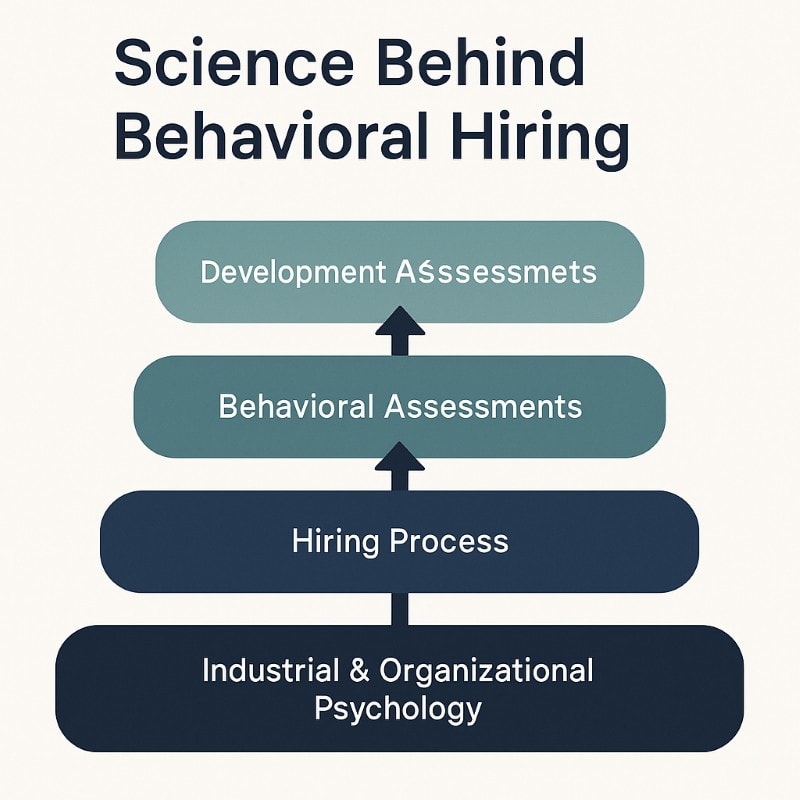
From Data to Decisions: Behavioral Assessments in the Hiring Process
Knowing which candidate has the right skills is only part of the equation. The real advantage of behavioral assessments for hiring is how they integrate into the recruitment process to give hiring managers a clearer path from screening to decision-making. Behavioral assessments can be tailored to predict candidate performance and fit for various jobs within an organization, ensuring the right match for each position.
Here’s how leading organizations use them:
- Screening ProcessCandidates often look similar on paper. A behavioral test early in the process helps filter applicants based not only on qualifications, but also on behavioral traits that align with the role.
- Applicant Tracking Systems (ATS)Many modern ATS platforms now integrate behavioral data, giving hiring teams a comprehensive view of each candidate alongside resumes and skills assessments. This ensures decision-makers aren’t just comparing hard skills, but also evaluating cultural alignment and team dynamics.
- Structured Hiring DecisionsBy the time candidates reach final interviews, hiring teams have data-driven insights to guide their questions. Instead of asking generic prompts, managers can probe deeper into specific behaviors highlighted by the assessment.
- Hiring Team AlignmentWith objective data, the hiring team avoids bias-driven debates. Decisions become collaborative, evidence-based, and consistent across roles.
This structured integration creates a holistic view of the whole candidate, reducing the risk of hiring based on “gut feel” alone. For companies hiring at scale, these efficiencies not only improve accuracy but also speed up the recruiting process — ensuring top talent doesn’t slip away to competitors.
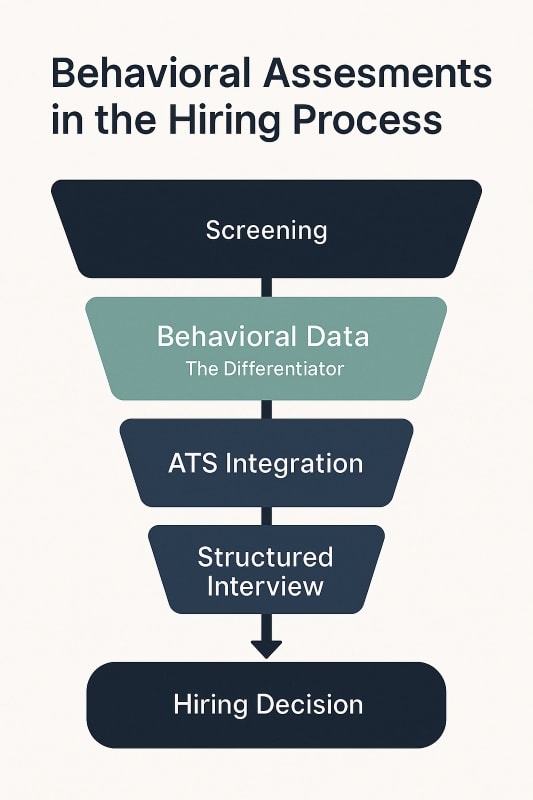
Real-World Applications
Behavioral assessments aren’t just theoretical tools — they’re already transforming how organizations hire, manage, and develop people across industries. Their value lies in their flexibility: whether you’re a small business filling a single open position or a global enterprise hiring hundreds, these tools adapt to the context. Behavioral assessments analyze a person’s traits, such as temperament, characteristics, and habits, to predict workplace behavior and suitability for specific roles.
Hiring for Particular Roles
Different roles require different behavioral strengths. For example:
- Sales positions benefit from high extraversion, resilience, and persuasion.
- Customer service roles demand empathy, patience, and emotional intelligence.
- Leadership roles require decision-making under pressure, vision, and the ability to align teams.
Behavioral assessments allow hiring managers to match a candidate’s personality traits with the behavioral demands of the role — increasing the likelihood of job success.
Small Business vs. Enterprise Adoption
Small businesses often face the challenge of one bad hire having an outsized impact. A poor fit in a team of five can disrupt culture and growth. For enterprises, the scale is different — but so is the risk. High-volume hiring means inefficiencies multiply quickly, and turnover can cost millions annually. In both cases, behavioral assessments provide actionable insights to make smarter hiring decisions.
Team Building and Cohesion
Beyond individual hires, behavioral assessments help leaders build balanced teams. By understanding the behavioral makeup of existing employees, HR leaders can identify gaps, predict potential conflicts, and design teams that align with the organization’s values and business goals. Companies like Amazon and Google have long leveraged data-driven hiring practices to ensure cultural alignment and innovation — and behavioral assessments bring that same precision to team dynamics.
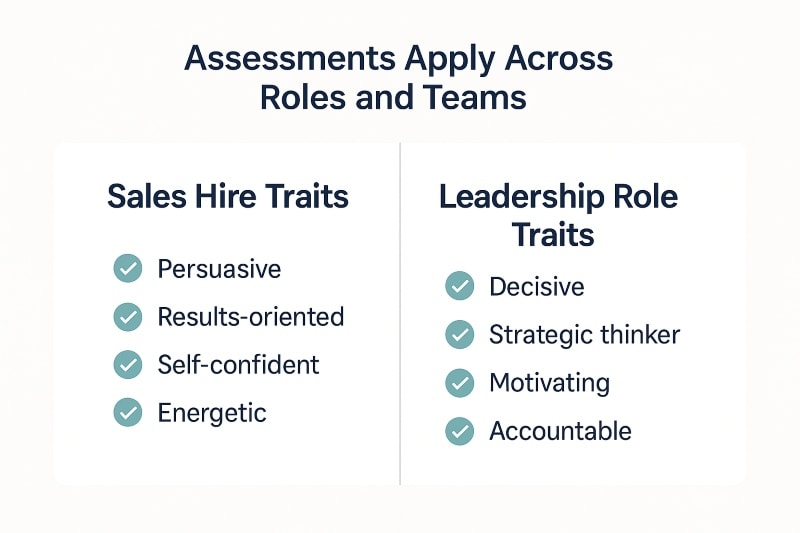
Reducing Bias and Increasing Fairness
One of the most powerful advantages of behavioral assessments is their ability to reduce hiring bias. Even the most experienced hiring managers are not immune to unconscious preferences — favoring candidates who share their background, communication style, or even alma mater. While often unintentional, these biases can narrow the talent pool and undermine diversity.
Behavioral assessments create a level playing field. Instead of evaluating candidates solely on how they present in an interview, assessments measure underlying traits and behaviors consistently across applicants. By focusing on data-driven insights, organizations can ensure that each candidate is judged by the same criteria.
This approach not only improves fairness, but also strengthens business outcomes. McKinsey research shows that companies with diverse leadership teams are 36% more likely to financially outperform their peers. By mitigating bias and supporting inclusion, behavioral assessments help organizations access top talent that might otherwise be overlooked.
It’s not about replacing human judgment — it’s about augmenting it. When hiring managers combine behavioral data with structured interviews and other scientifically validated methods, they make more objective, equitable, and ultimately more successful hiring decisions.
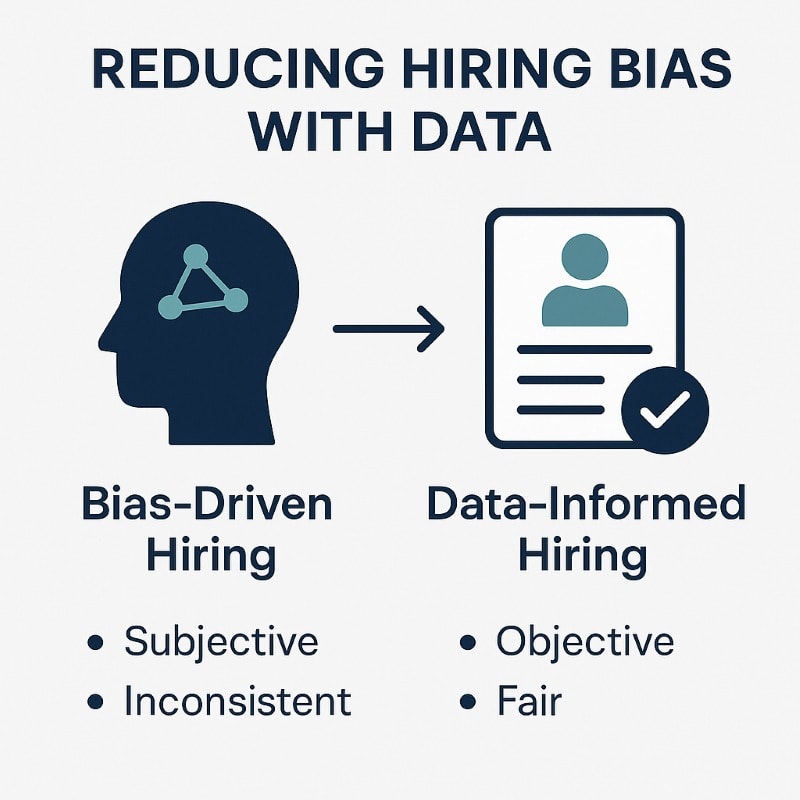
Beyond Hiring: Employee Development & Leadership Growth
The value of behavioral assessments doesn’t stop once a candidate signs the offer letter. Many of the most forward-thinking organizations use these tools to guide employee development, leadership growth, and long-term engagement. Behavioral assessments also play a crucial role in helping organizations select and onboard new employees who are more likely to succeed and stay with the company.
Supporting New Hires
Onboarding is one of the most critical stages of the employee lifecycle. By understanding a new hire’s behavioral traits upfront, managers can tailor their onboarding approach — providing targeted coaching, clarifying expectations, and avoiding mismatched work environments. This accelerates ramp-up time and strengthens retention.
Leadership Development
Behavioral assessments are equally powerful for identifying leadership potential. By highlighting traits like decision-making style, self-awareness, and emotional intelligence, they give organizations a framework to nurture future leaders. Warren Buffett once remarked that integrity, energy, and intelligence are the most important qualities in leaders — behavioral assessments give companies the ability to measure and develop those qualities systematically.
Team Alignment and Engagement
As organizations grow, misaligned teams can slow progress and weaken culture. By mapping out team behavioral dynamics, HR leaders can identify where strengths overlap, where gaps exist, and where conflict may arise. This makes it possible to proactively improve team cohesion and align individual behaviors with the company’s values and business goals.
In this way, behavioral assessments shift from being a one-time hiring tool to a strategic driver of employee engagement, retention, and leadership development. Companies that invest in understanding their people at this deeper level build workforces that are not just high-performing, but also deeply connected to the organization’s mission.
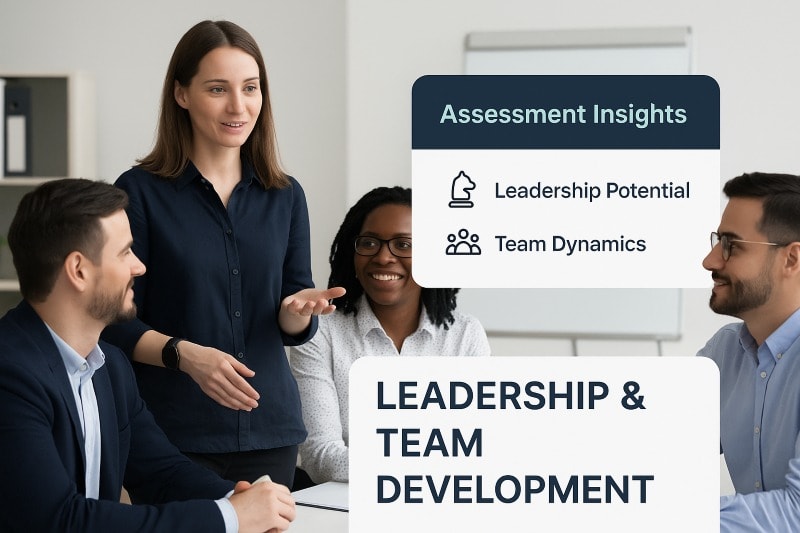
Challenges and Limitations of Behavioral Assessments
While behavioral assessments can be transformative, they are not without limitations. Understanding these challenges helps organizations use them responsibly and effectively.
Risk of Misuse
Not all assessments are created equal. Tools like the Myers-Briggs Type Indicator (MBTI), though popular, lack scientific validation for predicting workplace performance. When companies rely on unvalidated tests, they risk making flawed decisions and undermining credibility with candidates.
Over-Reliance on Data
Behavioral tests should never replace human judgment. Hiring managers who treat assessments as the only decision-making tool risk missing context — such as a candidate’s growth potential or unique experiences that don’t surface in test results. Behavioral assessments work best when combined with structured interviews, reference checks, and professional judgment.
Candidate Experience
If assessments are too long, confusing, or poorly explained, candidates may feel the process is impersonal. For high-demand talent, a cumbersome assessment can create friction that leads to drop-offs in the recruitment process. HR leaders must strike a balance between gathering meaningful insights and maintaining a positive candidate experience.
Privacy and Compliance
As with all data-driven tools, there are ethical and legal considerations. Employers must ensure compliance with regulations and safeguard sensitive candidate data. Transparency about how results will be used builds trust and demonstrates fairness.
The lesson is clear: behavioral assessments are powerful, but they must be scientifically validated, thoughtfully applied, and paired with human expertise to deliver the best outcomes.
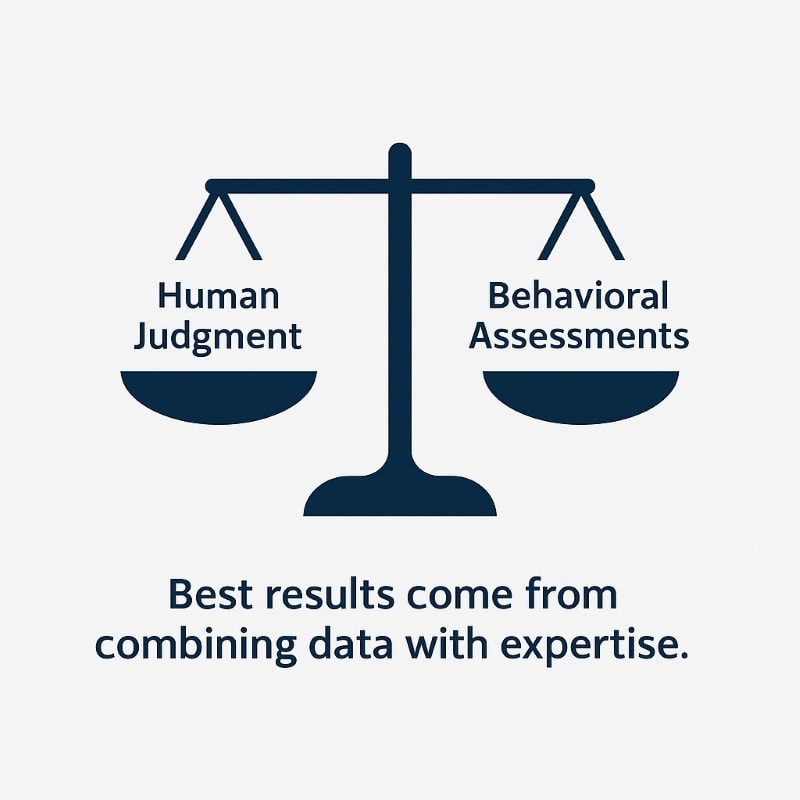
Building a Recruitment Strategy with Behavioral Assessments
To unlock the full value of behavioral assessments, organizations must weave them into a comprehensive recruitment strategy. This means treating assessments not as an add-on, but as a core component of the hiring framework.
Step 1: Define the Role Clearly
Before testing begins, hiring managers and HR leaders should map out the behavioral traits most critical for success in the particular role. For example, analytical problem-solving for data scientists, or empathy and communication for customer service positions.
Step 2: Integrate Assessments into the Screening Process
Behavioral assessments can be used early in the recruitment process to filter candidates who demonstrate alignment with the role’s demands and the organization’s values. This creates a more focused candidate pool for structured interviews.
Step 3: Combine Data with Structured Interviews
Once top candidates are identified, hiring teams can use assessment insights to tailor interview questions. This ensures interviews probe deeper into areas highlighted by the assessment, rather than relying on generic prompts.
Step 4: Align with Business Goals and Company Values
A successful recruitment strategy doesn’t just fill open positions — it builds a workforce aligned with the organization’s values and long-term business goals. Behavioral assessments provide actionable insights into cultural alignment and team dynamics, helping organizations avoid mismatched hires.
Step 5: Create a Feedback Loop
Finally, companies should evaluate how well assessments predict real-world performance. By tracking new hires over time, HR leaders can refine their models, improve accuracy, and continuously strengthen their recruiting process.
When applied systematically, behavioral assessments shift hiring from reactive to strategic — reducing turnover, improving cultural fit, and ensuring organizations consistently hire the right candidate for the role.
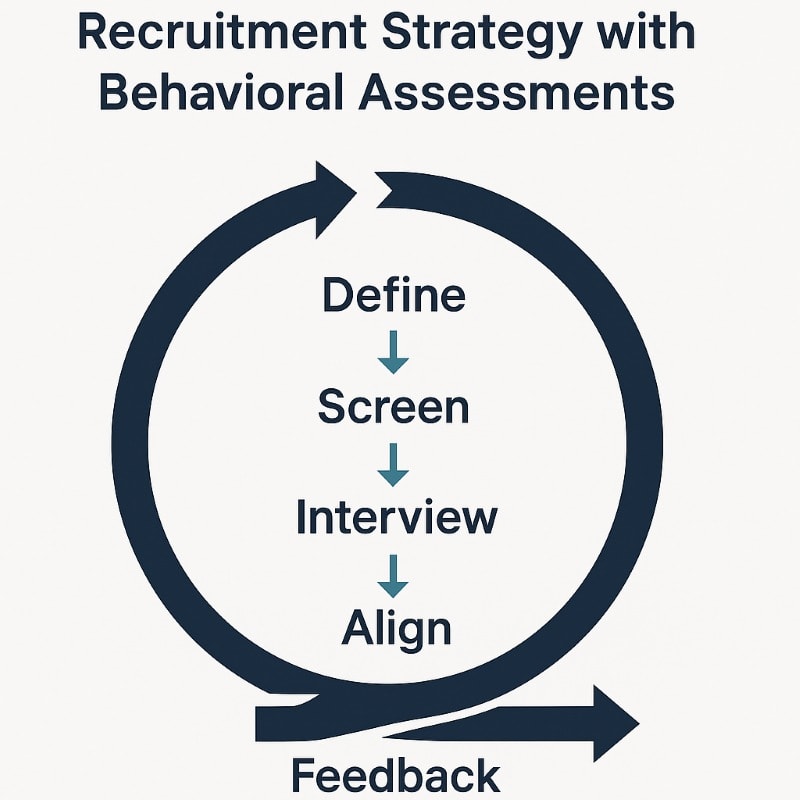
The Future of Hiring: Data Meets Human Resources
Hiring is no longer just an art — it’s rapidly becoming a science. As organizations compete for top talent, the future of recruitment lies at the intersection of data science and human resources. Behavioral assessments play a central role in this evolution, providing structured, measurable data that can be analyzed alongside other workforce metrics.
AI and Predictive Analytics
Modern recruitment strategies are increasingly powered by AI-driven insights. By combining behavioral data with machine learning, organizations can predict outcomes like job performance, turnover risk, and cultural alignment with greater accuracy than ever before. This creates a proactive approach — identifying the right candidate before issues arise.
Integration with Applicant Tracking Systems
Applicant Tracking Systems (ATS) are no longer just resume databases. Today, many integrate behavioral and psychometric assessment results, giving hiring managers a comprehensive view of the whole candidate in a single platform. This integration accelerates the recruiting process while ensuring data-driven consistency.
The Rise of the “People Scientist”
Forward-looking organizations are blending HR expertise with data science capabilities. These “people scientists” analyze behavioral assessments, engagement surveys, and performance data to generate actionable insights that drive hiring, development, and retention strategies. Companies hiring with this mindset are better equipped to align workforce planning with long-term business goals.
The future of hiring belongs to companies that balance the human element of HR with the rigor of data science. Behavioral assessments are the bridge — translating complex human behaviors into clear, predictive signals that organizations can use to hire and develop talent strategically.
Conclusion: Hiring Smarter Starts with Behavioral Assessments
The hiring process has always been high-stakes — but in today’s competitive market, the margin for error is thinner than ever. Traditional tools like résumés and interviews reveal only part of the story, leaving companies vulnerable to costly missteps and cultural mismatches.
Behavioral assessments for hiring provide the missing piece: a science-backed, data-driven lens into how candidates will actually perform, adapt, and collaborate in the real work environment. By integrating these tools into recruitment strategies, organizations can reduce turnover, mitigate hiring bias, and align talent decisions with long-term business goals.
The leaders who succeed tomorrow won’t be those who rely on gut instinct today. They’ll be the ones who combine behavioral science with strategic vision — hiring not just for skills, but for culture, cohesion, and future potential.
If your organization is ready to move beyond guesswork and start building stronger teams with confidence, the next step is simple:
Test OAD for free to see how our scientifically validated behavioral assessments can help you identify the right candidates, reduce costly turnover, and strengthen your organization from the inside out.

